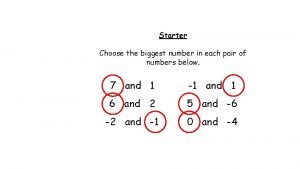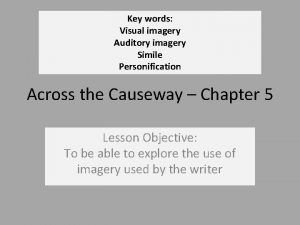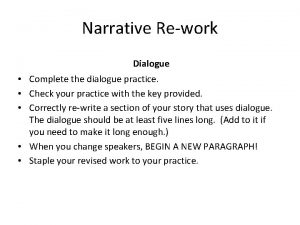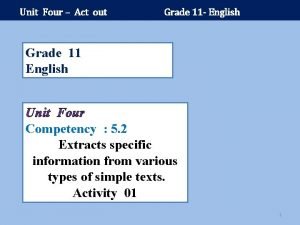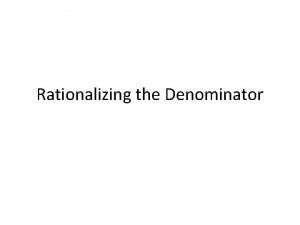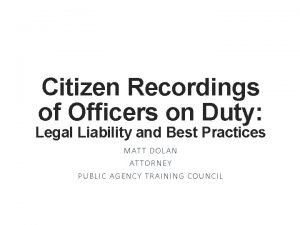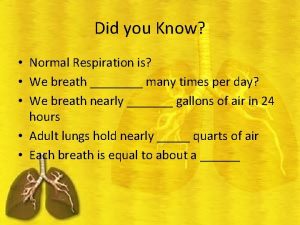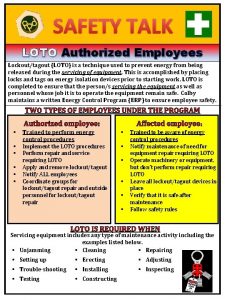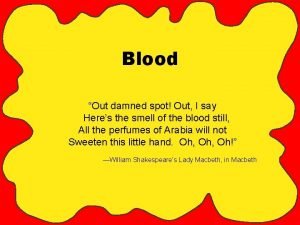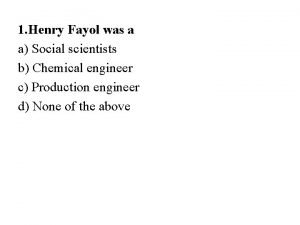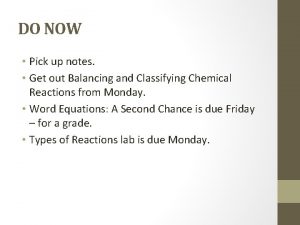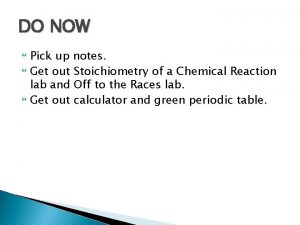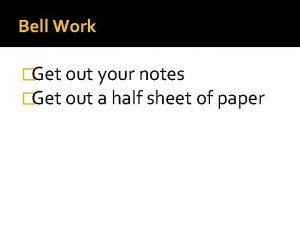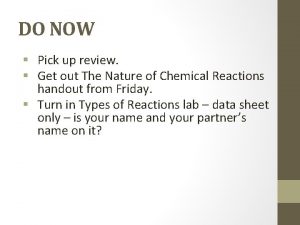DO NOW Pick up notes Get out MolarityMolality











































- Slides: 43

DO NOW Pick up notes. Get out Molarity/Molality handout.

COLLIGATIVE PROPERTIES “colligative” These – depending upon the collection are properties that depend on the concentration (the number of) of the solute particles. They are independent of the type of solute particle. Three Factors: Vapor pressure reduction Boiling Point Elevation Freezing Point Depression

VIDEO Colligative Properties 1. Support one of the following hypotheses about why it helps to add salt to the water before cooking the pasta: a) The salt brings the water to a boil sooner; or b) The salt brings the water to a boil at a higher temperature. 2. Which antifreeze solution boils at the highest temperature? Which solution would you want in your car on a hot summer day? Explain your reasoning. 3. On cold winter days, unprotected radiator water can freeze and expand, which can ruin an engine by cracking the engine block. Which antifreeze mixture would you want in your car on a cold winter day?

VAPOR PRESSURE: A REVIEW A Review: Vapor pressure arises because some molecules of pure liquid leave the liquid surface and enter the gas phase. At the same time, condensation occurs. If the rate of condensation and the rate of vaporization are equal, then the system is in equilibrium. The gas pressure resulting from the vapor molecules over the liquid is VAPOR PRESSURE.

VAPOR PRESSURE REDUCTION

VAPOR PRESSURE REDUCTION

VAPOR PRESSURE REDUCTION The vapor pressure of a solvent containing a nonvolatile solute is LOWER than the vapor pressure of the pure solvent. It is NOT dependent upon the type (identity) of the solute. WHY: The solute takes up space at the surface of the liquid and prevents some solvent molecules from evaporating. Now, more molecules leave the gas phase than enter it and therefore, the vapor pressure is lower.

BOILING POINT REVIEW A REVIEW: The boiling point of a substance is the temperature at which the vapor pressure of a liquid is equal to the external pressure on its surface (usually atmospheric pressure).

BOILING POINT ELEVATION A solution has a higher boiling point than the pure solvent. WHY: An addition of solute lowers that vapor pressure, therefore a higher temperature is necessary to get the vapor pressure up to the external (atmospheric) pressure so that the solution will boil.


FREEZING POINT: A REVIEW The freezing point of a substance is the temperature at which the vapor pressure of the solid and liquid phases are the same.

FREEZING POINT ELEVATION A solution has a lower freezing point than the pure solvent. WHY: An addition of solute lowers that vapor pressure, therefore a lower temperature is necessary to get the vapor pressure of the liquid to equal the vapor pressure of the solid. When a dissolved solute lowers the freezing point of its solution, you have freezing point depression.

FREEZING POINT DEPRESSION Club Soda demo Animation for Freezing Point depression


THE CALCULATION Dissociation factor molality T = (K)(df)(m) constant (molal freezing pt or boiling pt)

THE CALCULATION ∆T is directly proportional to the molality of the solution. Tbp is the difference between the boiling point of the solution and the boiling point of the pure solvent. It is directly proportional to the number of solute particles per mole of solvent particles. Tfp is the difference between the freezing point of the solution and the freezing point of the pure solvent. It is directly proportional to the number of solute particles per mole of solvent particles.

THE CALCULATION § § The dissociation factor, df, is how many particles the solute breaks up into. For a non-ionic compound (nonelectrolyte, organic compound), the df = 1.

CHEMICALS USED TO MELT ICE Formula Lowest Temp Pros Cons (NH 4)2 SO 4 -7. 0°C fertilizer Damages concrete Ca. Cl 2 -29. 0°C Melts ice faster than Na. Cl Attracts moisture; surfaces can be slippery Mg. Cl 2 -15. 0°C Melts ice faster than Na. Cl Attracts moisture CH 3 COOK -9. 0°C biodegradable corrosive KCl -7. 0°C fertilizer Damages concrete Na. Cl -9. 0°C Keeps sidewalks dry Corrosive; damages concrete and vegetation CMA -9. 0°C Safest for concrete and vegetation Works better at preventing re-icing

CALCULATIONS: NON-IONIC Determine the freezing and boiling point for 85. 0 g of sugar (C 12 H 22011) in 392 g water. Need these things: 1. Molality, m – need moles solute and kilograms of solvent 2. Number of particles (should be one) 3. Change in temperature

CALCULATIONS: NON-IONIC Molality 392 g H 2 O 1. 1 kg 1000 g m = 85. 0 g C 12 H 22011 0. 392 Kg H 2 O = 2. = 0. 392 Kg 1 mol C 12 H 22011 342. 34 g C 12 H 22011 df = 1 (non-ionic solute)

CALCULATIONS: NON-IONIC Change in Freezing point temperature: Tfp = (Kfp)(df) (m) = 1. 853 C 1 0. 633 m m = New Freezing Point: 0. 00 C – Freezing point of pure water

CALCULATIONS: NON-IONIC Change in boiling point temperature: Tbp = (Kbp)(df) (m) = 0. 515 C 1 0. 633 m m = New Boiling Point: 100. 000 C + Boiling point of pure water

PRACTICE What is the freezing point for a solution of 210. 0 g of glycerol dissolved in 350. 0 g of water? (The molecular mass of glycerol is 92. 11 g/mol) FP = ? Solute = 210. 0 g glycerol Solvent = 350. 0 g H 2 O

PRACTICE What is the freezing point for a solution of 210. 0 g of glycerol dissolved in 350. 0 g of water? (The molecular mass of glycerol is 92. 11 g/mol) 1. m = 210. 0 g gly 1 mole gly 1000 g 350. 0 g H 2 O 92. 11 g gly 1 kg = 6. 51395 = 6. 514 m 2. Df = 1 3. Tf = (Kf)(df)(m) = (1. 853ºC/m)(1)(6. 514 m) = 12. 070 = 12. 07ºC New FP = 0. 000ºC – 12. 07ºC = -12. 07ºC

CALCULATIONS: IONIC Determine the freezing and boiling point for 21. 6 g Ni. SO 4 in 100. 0 g water. Need these things: 1. Molality 2. Number of ions 3. Change in temperature

CALCULATIONS: IONIC Calculate molality: 100. 0 g H 2 O 1 kg 1000 g 1. m= = 21. 6 g Ni. SO 4 0. 1000 Kg H 2 O = 0. 1000 Kg 1 mol Ni. SO 4 154. 76 g Ni. SO 4

CALCULATIONS: IONIC 2. Determine the number of ions: Substance is Ni. SO 4 There are two ions, Ni+2 and SO 4 -2, so the df is

CALCULATIONS: IONIC 3. Calculate the change in temperature and the new freezing point. Tfp = 1. 853 C 2 1. 40 m m 0. 00 C – =

CALCULATIONS: IONIC Tbp = 0. 515 C 2 1. 40 m m 100. 00 C + =

CALCULATIONS: IONIC What is the boiling point of a solution containing 34. 3 g of Mg(NO 3)2 dissolved in 0. 107 kg of water? (The formula mass of magnesium nitrate is 148. 32 g/mol. ) Bp =? Solute 34. 3 g Mg(NO 3)2 Solvent 0. 107 kg

CALCULATIONS: IONIC 1. m = 34. 3 g Mg(NO 3)2 1 mole Mg(NO 3)2 0. 107 kg 148. 32 g Mg(NO 3)2 = 2. 16127796 = 2. 16 m 2. Df = 3 Mg+2 NO 3 -1 3. Tb = (Kb)(df)(m) = (0. 515ºC/m)(3)(2. 16 m) = 3. 3372 = 3. 34ºC New BP = 100. 0000ºC + 3. 34ºC = 103. 34ºC

RECAP A solution reduces the vapor pressure of the pure solvent. Vapor pressure reduction results in freezing point depression (lowering) and boiling point elevation. To solve these problems, you need: Molality Dissociation factor (Number of ions) Molal BP/FP constant (given to you)

RECAP Calculating freezing point change: Tfp = (Kfp)(df)(m) Calculating boiling point change: Tb = (Kb)(df)(m) Final step is to subtract from true freezing point or add to true boiling point.

DETERMINING MOLAR MASS Colligative properties provide a useful means to experimentally determine the molar mass (molecular mass in one mole) of an unknown substance. Steps: 1. Solve for molality. 2. Solve for moles of solute. 3. Solve for molar mass This is basically going backwards.

DETERMINING MOLAR MASS A 10. 0 g sample of an unknown organic compound is dissolved in 0. 100 kg water. The boiling point of the solution is elevated to 0. 433 o. C above the normal boiling point of water. What is the molar mass? solute = 10. 0 g Solvent = 0. 100 kg water Tbp = 0. 433 o. C df = 1

DETERMINING MOLAR MASS Step One: determine molality Tbp = Kbp df m m = Tbp Kbp = 0. 433 o. C = 0. 841 m (mol/kg) 0. 515 o. C/m Assume df = 1 because it is an unknown ORGANIC compound (not ionic).

DETERMINING MOLAR MASS Step Two: Determine moles of solute m = mol solute Kg solvent mol solute = m x kg solvent = 0. 841 mol/kg x 0. 100 kg = 0. 0841 mol

DETERMINING MOLAR MASS Step Three: Determine Molar Mass mol solute = mass solute molar mass = mass solute = 10. 0 g mol solute 0. 0841 mol = 118. 90606 = 119 g/mol

DETERMINING MOLAR MASS PRACTICE: A solution of 3. 39 g of an unknown in 10. 00 g of water has a freezing point of – 7. 31 o. C. The solution is a nonelectrolyte. What is the molar mass of the compound? (The molal freezing point constant of water is 1. 853 C/m. ) Mass solute = 3. 39 g Mass solvent = 10. 00 g FP = – 7. 31 o. C ΔTfp = 7. 31 o. C df = 1

DETERMINING MOLAR MASS PRACTICE: A solution of 3. 39 g of an unknown in 10. 00 g of water has a freezing point of – 7. 31 o. C. The solution is a nonelectrolyte. What is the molar mass of the compound? (The molal freezing point constant of water is 1. 853 C/m. ) Step One: determine molality Tfp = Kfp df m m= Tfp = 7. 31 o. C Kbp df (1. 853 o. C/m)(1) = 3. 94 m

DETERMINING MOLAR MASS PRACTICE: A solution of 3. 39 g of an unknown in 10. 00 g of water has a freezing point of – 7. 31 o. C. The solution is a nonelectrolyte. What is the molar mass of the compound? (The molal freezing point constant of water is 1. 853 C/m. ) Step Two: Determine moles of solute m = mol solute Kg solvent mol solute = m x kg solvent = 3. 44 m x 0. 01000 kg = 0. 0394 mol

DETERMINING MOLAR MASS PRACTICE: A solution of 3. 39 g of an unknown in 10. 00 g of water has a freezing point of – 7. 31 o. C. The solution is a nonelectrolyte. What is the molar mass of the compound? (The molal freezing point constant of water is 1. 853 C/m. ) Step Three: Determine Molar Mass mol solute = mass solute molar mass = mass solute = 3. 39 g mol solute 0. 0394 mol = 86. 040609 = 86. 0 g/mol

TO DO Handout due tomorrow. Solubility of KNO 3 lab due tomorrow.
 One direction shot me out of the sky
One direction shot me out of the sky Get on / get off transport
Get on / get off transport What are pick up notes
What are pick up notes Food chain of rabbit
Food chain of rabbit Solving linear inequalities hangman
Solving linear inequalities hangman Imagery simile
Imagery simile Manisha has secured 79 marks in the college exam
Manisha has secured 79 marks in the college exam Now i see it now you don't
Now i see it now you don't Hooray cheered gilda. does that mean we can stay?
Hooray cheered gilda. does that mean we can stay? Smash mouth somebody once told me
Smash mouth somebody once told me Confirm your email now and get 5 minutes as a gift!
Confirm your email now and get 5 minutes as a gift! Get up get moving quiz
Get up get moving quiz Get up get moving quiz
Get up get moving quiz Get up get moving
Get up get moving Get sequence get another sequence pseudocode
Get sequence get another sequence pseudocode Get focused get results
Get focused get results Germer
Germer Act out the following dialogue
Act out the following dialogue Oh that old rugged cross my salvation
Oh that old rugged cross my salvation How to get a radical out of the denominator
How to get a radical out of the denominator Get out of jail free card
Get out of jail free card Get out of my school
Get out of my school What options did an accused witch have in salem
What options did an accused witch have in salem Get the word out we back up
Get the word out we back up Do words have power
Do words have power The second foundation get out of debt
The second foundation get out of debt It's not paranoia
It's not paranoia A piece get out of paper
A piece get out of paper What is getting the wind knocked out of you
What is getting the wind knocked out of you Cube wisc
Cube wisc Put out the light then put out the light
Put out the light then put out the light Robert frost poems
Robert frost poems Out of sight out of mind quote
Out of sight out of mind quote Allusion in out out by robert frost
Allusion in out out by robert frost Loto safety talk
Loto safety talk Out, out by robert frost
Out, out by robert frost Lily gulledge
Lily gulledge Are you tired worn out burned out on religion
Are you tired worn out burned out on religion Lock out tag out pictures
Lock out tag out pictures Out, damned spot! out, i say!
Out, damned spot! out, i say! Henri fayol parents
Henri fayol parents Makna out of sight out of mind
Makna out of sight out of mind Log out tag out deutsch
Log out tag out deutsch Pcisp
Pcisp




